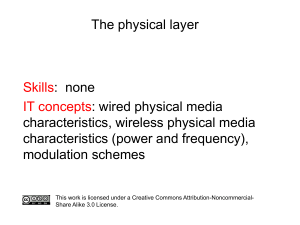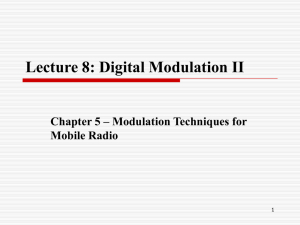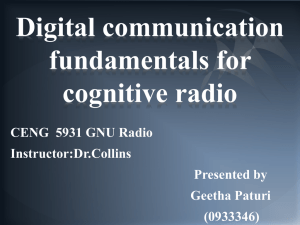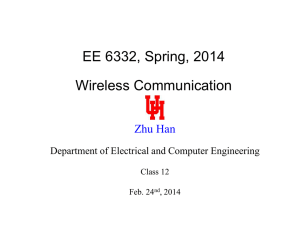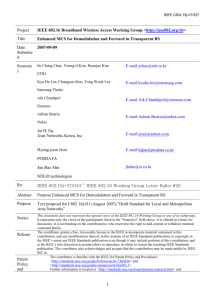Vel-WC-UNIT
advertisement
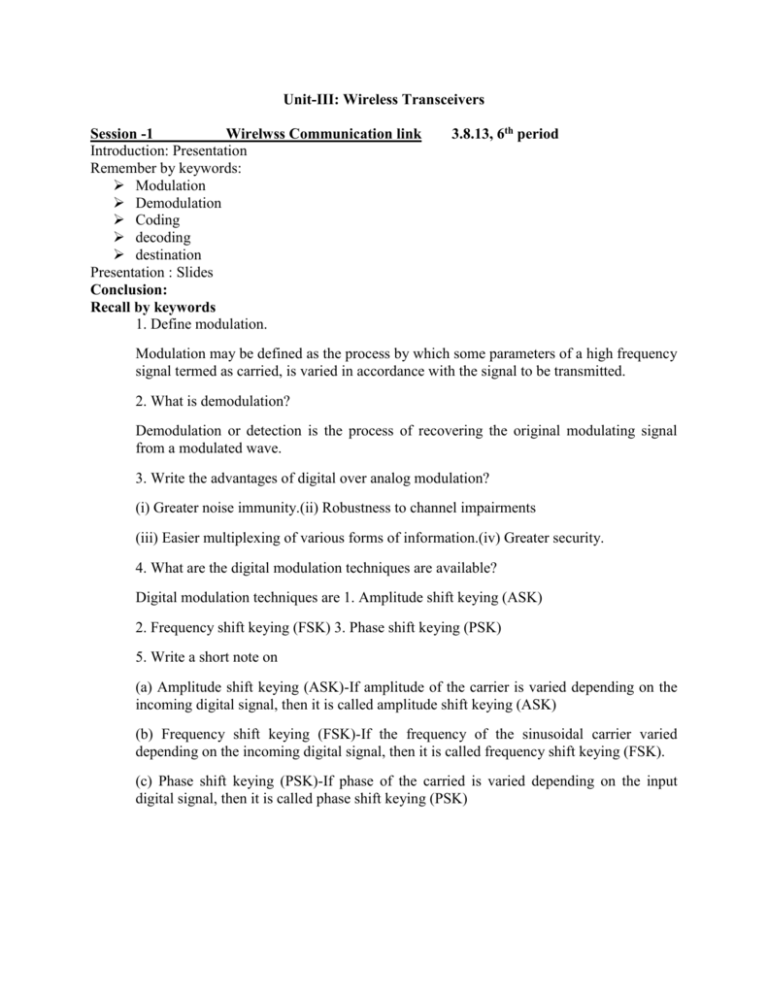
Unit-III: Wireless Transceivers Session -1 Wirelwss Communication link Introduction: Presentation Remember by keywords: Modulation Demodulation Coding decoding destination Presentation : Slides Conclusion: Recall by keywords 1. Define modulation. 3.8.13, 6th period Modulation may be defined as the process by which some parameters of a high frequency signal termed as carried, is varied in accordance with the signal to be transmitted. 2. What is demodulation? Demodulation or detection is the process of recovering the original modulating signal from a modulated wave. 3. Write the advantages of digital over analog modulation? (i) Greater noise immunity.(ii) Robustness to channel impairments (iii) Easier multiplexing of various forms of information.(iv) Greater security. 4. What are the digital modulation techniques are available? Digital modulation techniques are 1. Amplitude shift keying (ASK) 2. Frequency shift keying (FSK) 3. Phase shift keying (PSK) 5. Write a short note on (a) Amplitude shift keying (ASK)-If amplitude of the carrier is varied depending on the incoming digital signal, then it is called amplitude shift keying (ASK) (b) Frequency shift keying (FSK)-If the frequency of the sinusoidal carrier varied depending on the incoming digital signal, then it is called frequency shift keying (FSK). (c) Phase shift keying (PSK)-If phase of the carried is varied depending on the input digital signal, then it is called phase shift keying (PSK) Session -2 BPSK,QPSK–Modulation and demodulation Recap: By keywords Phase modulation Phase shift keying Frequency modulation Short seminar: PSK modulation Presentation: Slides www.youtube.com/watch?v=vXnOScHEWQQ vada.skku.ac.kr/ClassInfo/digital-com2000/.../digital-modulation.ppt 5.8.13, 4th period Conclusion: Recall by words Bit rate, symbol rate, error probability 1. Define baud rate. Speed at which symbols (signals) are transmitted in a digital communications system. Simply no. of symbols/second. 2. Define bit rate. Speed at which data (Bits) is transmitted in a digital communication system. Simply no. of bits/second. 3. What is QAM? At high bit rates, a combination of ASK and PSK is employed in order to minimize the errors in the received data. This method is known as “quadrature amplitude modulation”. 4. Define QPSK. QPSK is a multilevel modulation in which four phase shifts are used for representing four different symbols. 5. Define linear modulation? In linear modulation techniques, the amplitude of the transmitted (carrier) signal varies with the modulating digital signal. 6.Differentiate linear, non-linear modulation. linear modulation nonlinear modulation In the linear modulation the amplitude of the carrier is not constant, regardless of the variation in the modulating signals In the non linear modulation the amplitude of the carrier is constant, regardless of the variation in the modulating signals. Non-linear modulations may have either linear or constant envelops depending on whether or not the base band waveform is pulse shaped. (i) Power efficient class C amplifiers can be used without introducing Degradation in the spectrum (ii) Very attractive for use in occupancy of the transmitted signal. wireless communication systems (ii) Low out of band radiation of the order of and 60dB to -70 dB can be achieved. (iii) Accommodate more and more users within a limited (iii) Limiter-discriminator detection can be used, which simplifies receiver design and provides spectrum. high immunity against random FM noise and Signal fluctuations due to Rayleigh fading. Merits:(i) Bandwidth efficient. Demerits:poor power efficient (i) Constant envelope modulations, occupy a examples of linear modulation larger bandwidth than linear modulation schemes. are (ii) In situations where bandwidth efficiency is more important than power efficiency, constant (i) Pulse shaped QPSK envelope modulation is not well-suited. Eg.,BPSK (ii) OQPSK (iii) \/4QPSK Session -3 π/4 QPSK, offset QPSK- modulation and demodulation 6.8.13,4th Remember by Keywords Bit rate symbol rate Linear non-linear modulation Short seminar: QPSK modulation Presentation: slides ae.hc.cust.edu.tw/new_website/attachments/article/.../Lecture%207.ppt faraday.ee.emu.edu.tr/ee569/Rappaport/wirelessSlidesCh06.ppt www.cse.ohio-state.edu/~anish/788Notes/Wireless_Transmission.ppt Conclusion: questions 1. Why we go for offset QPSK? 2. Few words about OQPSK. 3. Differentiate QPSK AND π/4 QPSK 4. List the advantages of OQPSK. Session -4 BFSK modulation and demodulation Recap: keywords and short seminar Frequency modulation FSK Coherent and non-coherent detection 8.8.13,5th period Content: Presentation by slides Generation of FSK mail.alquds.edu/~f2095/Communication%20Systems/Ch5a.ppt feihu.eng.ua.edu/NSF_TUES/Modulation.ppt www.youtube.com/watch?v=EeHu5EyxPrk Conclusion: Recall by words Generation detection technique Error propagation Session – 5 principle and operation of MSK 12.8.13,4th period Introduction: Presentation with Video www.youtube.com/watch?v=ifgsouypc78feature=relmfu Presentation : by slides www.ti.com/ww/cn/uprogram/share/ppt/c5000/21modulation_v110.ppt xa.yimg.com/kq/groups/23381305/2114408970/name/MSK.ppt Conclusion: Keywords BT Product Constant envelop Session -6 principle and operation of GMSK 13.8.13,4th period Recap: Keywords MSK FSK Constant envelop modulation Content: Presentation slides www.ti.com/ww/cn/uprogram/share/ppt/c5000/21modulation_v110.ppt www.radio-electronics.com › RF topics Session -7 power spectrum 16.8.13, 7th period Recap: keywords Spectrum Wireless spectrum limitations Power spectrum Presentation : Slides www.federica.unina.it/ingegneria/wireless-networks/digital-schemes www.cyut.edu.tw/~yfahuang/huang/EX0387CH03.pdf Conclusion : keywors Bandwidth occupancy Power efficiency Bandwidth efficiency Session -8 QPSK, BFSK system error performance Content: Presentation using video clips http://www.youtube.com/watch?v=vtiup1w1c4E&feature=related Conclusion: Remember by keywords generation detection Error probability 17.8.13, 4th period Session -9 MSK, GMSK system error performance analysis 17.8.13, 6th Content: Presentation slides http://www.youtube.com/watch?v=PNMuf8twHqw&feature=related http://www.youtube.com/watch?v=eehh0DXLv10&feature=relmfu Conclusion: Questions and answers 1. Distinguish between MSK,GMSK 2.Write the properties of QPSK. 3.Compare QPSK,MSK,FSK

